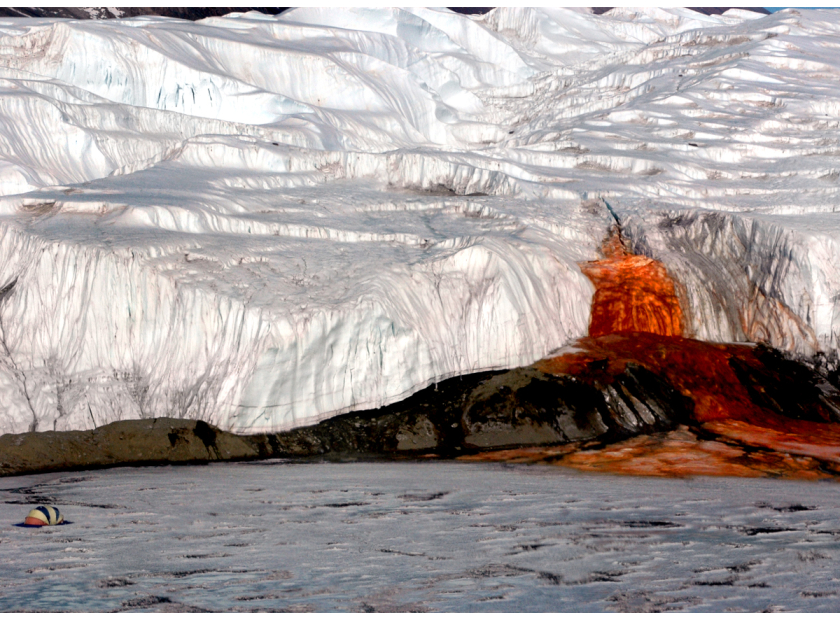Bleeding Glaciers and Autotrophic bacteria
No, Blood Falls is not the newest Norwegian metal band, but it is actually a naturally occurring geologic wonder. Blood falls flows out of the Taylor Glacier in Antarctica onto the neighboring West Lake Bonney which is completely frozen over. The isolated (even for Antarctica) anomaly as well as the glacier and valley was discovered in 1911 by an Australian geologist by the name of Griffith Taylor which is where the valley gets its name. The striking appearance of the falls is a stark contrast of color against a seemingly monochrome palette. Its rust red waters pour from small fissures in the glaciers toe creating a breathtaking scene of color five stories tall in a seemingly lifeless ice cascade. These waters quite obviously gave rise to the name Blood Falls, and it was believed for many years that a red algae was the cause of its vibrant hue. However, recent studies have revealed the science behind this eerie ooze.
 Jill Mikucki, a microbiology assistant professor at the University of Tennessee, is pictured in Antarctica while researching microbes.
Jill Mikucki, a microbiology assistant professor at the University of Tennessee, is pictured in Antarctica while researching microbes.The color as it turns out is attributed to an extremely high concentration of iron oxide, but as it turns out the color of the falls was not the only secret this anomaly kept. These falls located in one of the coldest and driest desert regions in the world (often likened to the deserts on Mars) is actually a host of microbial life. The water is actually an saline brine containing 17 different types of microorganisms. Geomicrobiologist Jill Mikucki from the University of Tennessee in Knoxville is one of the leading researchers of the falls. Her teams testing revealed that the briny waters contained almost no oxygen yet still hosted a variety of microorganisms. Her analyses indicate that these autotrophic bacteria actually metabolize sulfate and ferric ions. Meaning that, instead of oxygen, the microbes are using sulfate as a catalyst for respiration with ferric ions and metabolize the minute particles of organic matter trapped within. This process had never before been observed naturally.
But what was the timeline of events that created such a unique ecosystem. The current accepted theory is that a sub glacial pool was seal off around 1.5- 2 million years ago. Isolated, the population of micro bacteria had a sufficient period of time to evolve independently unlike other marine organisms. Recent studies confirm that the source of the Blood Falls is actually connected
to other subsurface lakes which has the potential for an even more extensive ecosystem below the ice.
Even more interesting is the implications this geological/microbial peculiarity has for the astrobiological community. As humanity reaches ever further into the cosmos, even considering colonization of other planetary bodies such as Mars and Europa, studies of these subsurface ecosystems becomes more prudent. Jupiter's ice covered moon Europa, for example, mirrors many of the conditions that would be found in the sub glacial lakes of the Taylor Glacier. Studies of the Blood Falls and its source could give us insight as to the plausibility of alien life below the barren ice of Europa's surface.
Blood falls has and will continue to captivate scientists for years to come. However, it won't simply be because of its vibrant reddish hues but because of the known life teeming beneath its icy facade. As research continues, the microbiology community is on the edge of its seat, eagerly waiting new discoveries and understanding of this "alien" microcosm.

Written by Daniel Ballew
Daniel is a Marketing Associate for Hardy Diagnostics. He earned his bachelor’s degree in History and a certificate in World Religions at California Polytechnic San Luis Obispo in San Luis Obispo, California where he studied mythology and the development of Christianity.
To see more, watch this fascinating video about the Blood Falls. See if you can't spot some Hardy media :)








